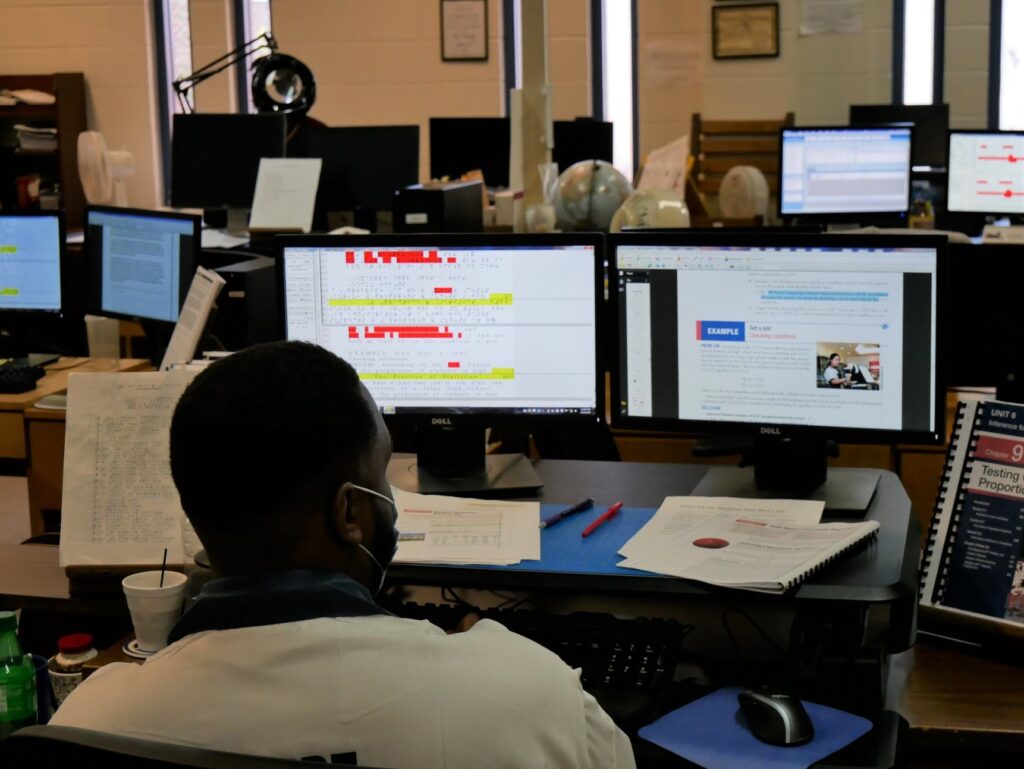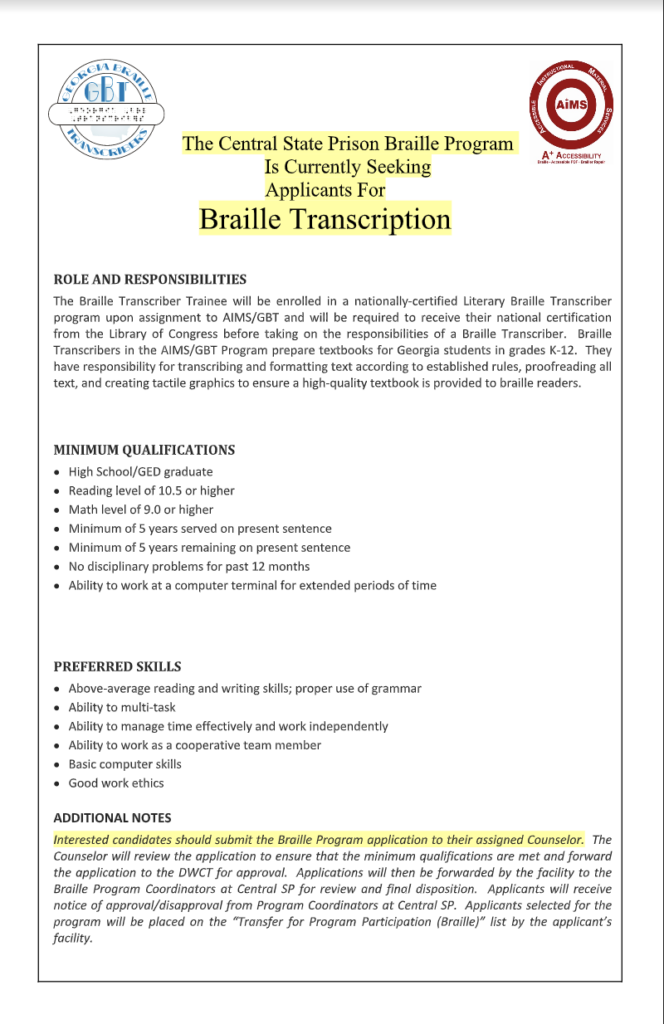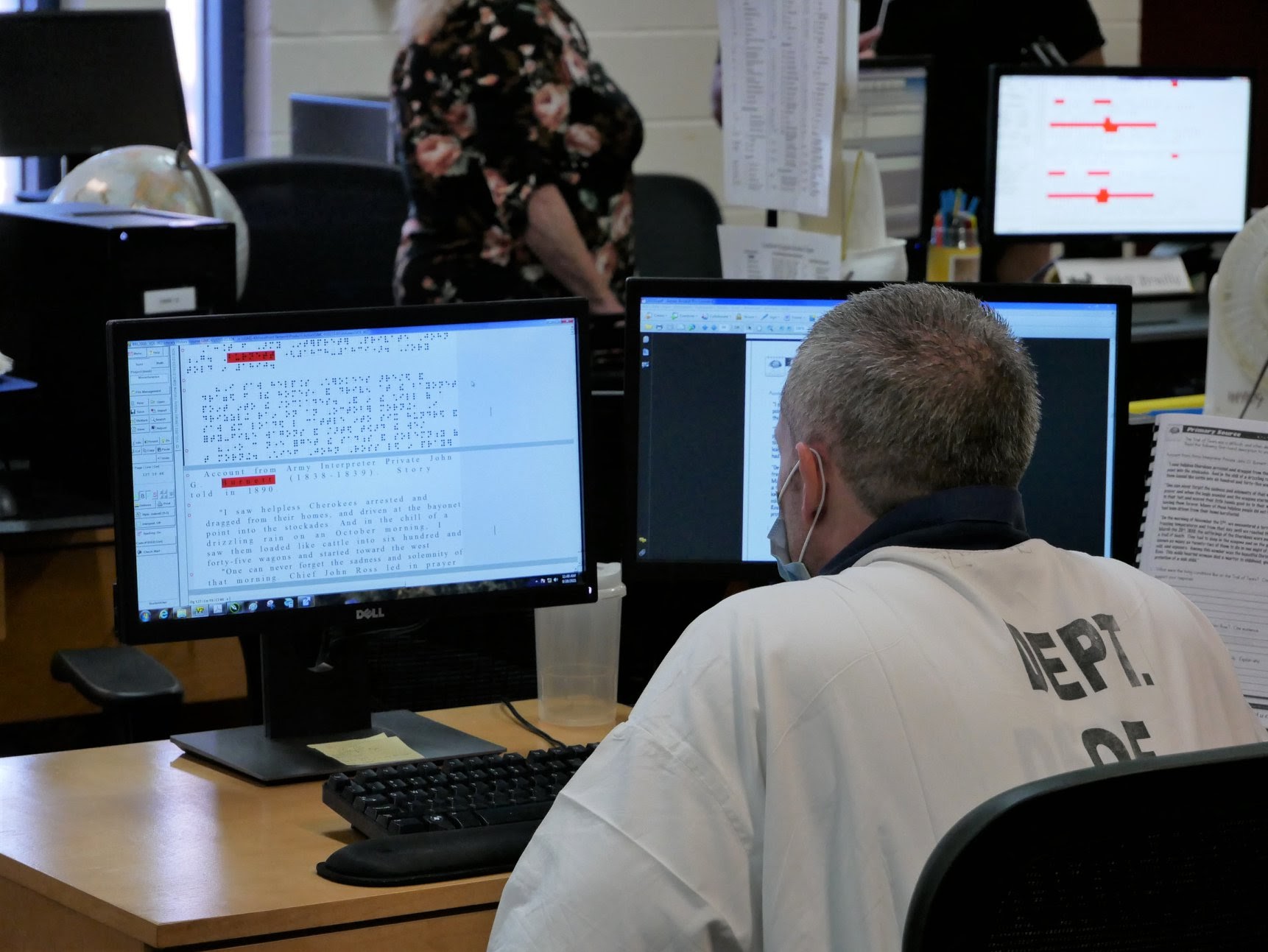In the Georgia Braille Transcribers (GBT) shop within Central State Prison, a sign informs visitors that the program has a zero-percent recidivism rate. At open houses and annual exhibitions, Parole Board members and other Georgia Department of Corrections (GDC) head honchos are proudly told that of the 100-plus Library of Congress-certified braille transcribers who have paroled out, none have returned to prison.
Someone once challenged this statistic by suggesting there’d been a single case of recidivism, prompting GBT to comb through 17 years of records until they found a name none of them remembered, and therefore they doubted belonged to someone who actually got certified.
Many transcribers have been with the program for over a decade, and a few long enough to have started when the work was still done entirely on Perkins Braillers—typewriters. Transcripts were churned out manually, one painstakingly slow page at a time.
The braille alphabet is a tactile system composed of “dots.” GBT uses the six-dot system, in which two columns of three dots each form one braille cell. A cell with the first dot (upper left) raised into a bump is the letter “A.” A cell with the first, third, fifth and sixth dots raised is “Z.” There are more than 200 combinations, also representing prefixes, suffixes and whole words.
In the early 2000s, a prisoner named Shawn Greiner got an administrator to give the idea of a braille transcribing detail a shot. Beginning at the now-shuttered Men’s State Prison, the original “Braille Cell” comprised 10 men working in a room of no more than 20 square feet. Two tables, four Perkins Braillers, four-man shifts. By the time they became the Braille Transcriber Association in 2004, they had produced a total of four textbooks.
By 2008, GBT had assumed its current name and nearly tripled in size. In 2011, the dining area of a Central State Prison annex was repurposed into a transcribing shop, and all transcribers in the men’s state prison system were brought to live and work at that facility. Emanuel Women’s Facility houses the braille transcribing program for the women’s state system.
In 2015, GBT all moved into the same living unit, the better to continue working during off hours. This idea didn’t come from GDC; transcribers made strategic demonstrations to higher-ups whenever they passed through, impressing them until a GBT dorm just seemed like the sensible thing to do. What administrators called maximizing output, GBT called peace and quiet, in one of the only two living units in the state prison system where the cell doors don’t lock you in.
In a system where prisoners struggle to access everything—from tablets to food to medical care to the ability to sleep indoors—the GBT dorm has secured two communal desktops, plus a thumb drive. Some of the current 24 transcribers use them to work in the evenings; others prefer to work during the night. GBT even fought for permission to send a computer to a transitional center, so that transcribers who’d made work-release could continue their braille work during off hours.
GBT is also a standout example of Georgia’s centuries-old tradition of profiting off involuntary servitude. Internal financial records reviewed by Filter showed the over the course of their transcribing “careers,” some individual prisoners have brought in hundreds of thousands of dollars for GDC. The annual profits generated by the program hover around $300,000. From this, the transcribers themselves are paid twice a year in pizza.
Transcribers are not generally inclined to talk to media, partly because as a group they’re protective of what they’ve built and wary of drawing heat, and partly because they’re busy. Everyone interviewed by Filter is currently incarcerated, and their names have been changed.

“You have to want to do braille for reasons bigger than money in order to be good at it,” Mark told Filter. “Although all we get for the work are a sane dorm, clean uniforms and a comfortable work area, having a reason to get out of bed is invaluable. Knowing that somewhere, someone will use this product … a lot of days, I hate to leave in the evenings.”
When work ends at 3:45 pm, the men are often seen carrying stacks of text back to the dorm so they can continue working until work resumes at 7:45 am. GBT has historically attracted applicants serving life sentences. When enough years pass that you come to terms with being enslaved, purpose is the next best thing to freedom.
Lifers are drawn to GBT because keeping the brain active is their best chance at remaining sane. As a group, paroled lifers are among the most determined to make meaningful contributions to society and thus among the least likely to recividate, which works out fine for prison administrators looking to impress the Parole Board.
GBT is only open to applicants with at least five years left on their sentence, for the sole reason that it takes at least a year of dedicated practice to become proficient at transcribing, and many more to become fluent. There’s a waiting list.
A single textbook can take three men up to six months to complete, and sell for upwards of $50,000.
The profitable era of GBT can be traced back to 2005, when the program received its first donated computers (outdated Macs; floppy-disk storage).
“Imagine copying a novel with a manual typewriter,” John told Filter. “That is what a Perkins Brailler is. Not even electric. Then, the next day—a computer with spell-check, redo and a (figurative) terabyte of accessible storage is on your desk. Once we got a grip on the new tools, we were flying.”
An embosser was bought secondhand. Textbook completions per year jumped from four to 40, which meant a tenfold increase in earnings as well. GBT currently has contracts with 91 customers, about one-third of which are state school systems. Textbooks are where the money’s at; a single contract with a large education system can represent a quarter of a million dollars.
Textbook transcriptions involve not just the plain text, but all glossaries, indexes and tactile graphics—maps in the history and geography books, graphs and pie charts in the math books. Most textbooks pay $4 per page. Math textbooks pay $6; some chemistry books pay $7. Tactile graphics are another $5 each. A single book, depending on number of pages and degree of difficulty, can take three men up to six months to complete and easily sell for tens of thousands. A recent math textbook contract paid $56,000.

A book that arrives in traditional print must be disassembled into separate pages; the pages scanned; the scans analyzed with Optical Character Recognition software; the analysis converted to plain text; and the text processed through a braille rendering program—which, like most automated transcription technologies, leaves something to be desired accuracy-wise. It therefore falls to transcribers to compare the original text to the braille text and correct the errors one by one.
At that point, the time for specialized machinery is more or less over. Once the text reaches the transcribers it’s an analog job, requiring creative problem-solving skills honed over many years.
Transcribers aren’t allowed to change anything from the original text. This can pose a dilemma, since such exhaustive scrutiny regularly turns up errors the original proofreaders missed. But when the error is significant enough to merit informing the publisher, that’s for the program supervisors to deal with; they’re the only ones allowed to use the internet.
Program supervisors are experienced educators, sometimes with braille experience but never with the corrections officer mentality of needing to micromanage everything to death, lest prisoners be allowed to make anything in prison work better.
Amid the cascading failures of the larger GDC system, GBT has managed to not only survive, but remain what by most objective metrics would be a remarkably successful program at any US prison system. Transcribers attribute this to a collective understanding around the vital importance of keeping GDC out of their business. GDC did not respond to Filter’s request for comment.
Nonetheless, GBT can feel prison middle-management creeping in, wanting more direct control of the budget. This has held up orders for workplace materials, which has held up production.
It’s not the only development expected to take some of the air out of next year’s numbers. GBT worked on Department of Education texts for nearly two decades, until recently when its former partners at the Georgia Institute of Technology decided to claim all DOE contracts for themselves. University staff still call GBT supervisors for help interpreting the infinitely convoluted transcription rules, so they can deliver on the contracts they took. And help they still receive—in the grander scheme of things, the point of GBT is to make education accessible to visually impaired students around the country, a responsibility the transcribers take pretty seriously.
“Transcribing these textbooks isn’t a given, at any step,” Tony told Filter. “Formatting the braille text is a detailed and strict process of rearranging all the sidebar information, and artistic presentation of material, into what the students have learned to expect. There are about a thousand pages of rules … I can’t imagine doing this job without a team, not in a timely manner anyway.”
Photographs of Central State Prison Braille Program via Georgia Department of Corrections. Inset image of GBT application via Anonymous.





Show Comments